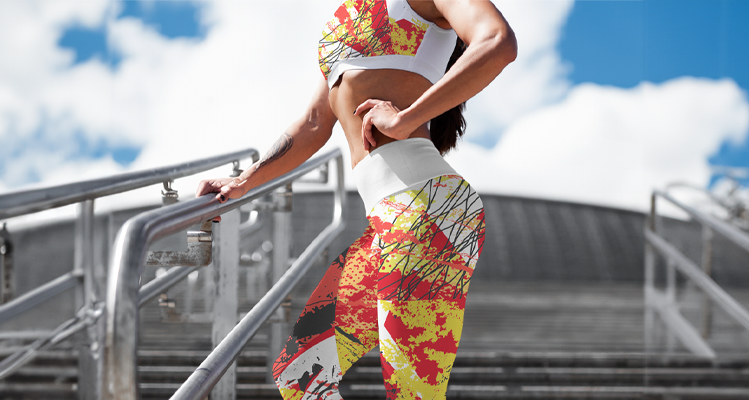
All about activewear: from sublimation paper to seam finishes
In order for athletes to overcome their challenges effectively, there are hurdles that must be cleared in the design of sportswear. This type of clothing, specifically activewear, goes beyond conventional fashion as it must cater to each sport, combining functionality, comfort, style, and durability.
It's a vast and complex world that we'll explore in this article, and we've already “equipped” ourselves with the best tips and techniques to make it a relaxing and rejuvenating experience. Join us and learn the entire process, from sublimation printing and the importance of the right paper to patterns and and seam finishes.
1. Sublimating perfectly
1.1. decal® Winner sublimation paper
Paper is crucial in the sublimation process to ensure the vibrancy of colors and design precision. The latest innovation in the market is the Winner sublimation paper, introduced by decal® with a specially formulated coating to control the amount of absorbed ink and retain it on the paper's surface. This facilitates and smoothens the transfer to the substrate.
Absorbing and retaining the ink in the right quantity allows for achieving the desired color and saturation, resulting in more precise, vivid, long-lasting, and fade-resistant applications. Furthermore, it significantly reduces ink consumption, lowering printing costs and the ecological footprint. Another advantage of this sublimation paper is its stability, as it doesn't curl during printing. Learn more about this innovation here.
1.2. Heat pressure
To achieve the expected results when transferring designs using heat and pressure, certain requirements must be met. During heat pressing, the fabric should be pressed at a temperature of 393°F / 200.56°C for 45 seconds. This meticulous calibration ensures perfect adhesion of the print, displaying vibrancy and durability.
1.3. Technical and sustainable fabrics
In the design of activewear pieces, fabrics specially engineered to absorb moisture, regulate body temperature, and provide elasticity for unrestricted movements are used. Materials like polyester, Lycra, and nylon are common due to their performance properties.
decal® has a partnership with greentex, known for its sustainable textiles that blend ecology, design, softness of touch, and comfort. Fabrics are made from recycled polyester, generating zero water waste and complying with the European Green Deal for all fabrics to be recycled or recyclable by 2030. Learn more about this partnership here.
2. Conceptualizing the ideal piece
2.1. Ergonomics and mobility
The design of activewear must adapt to the specific movements of physical activity. More than just looking good, garments must fit well to allow for maximum mobility and comfort, achieved through the incorporation of cuts, adjustments, and elastic panels.
2.2. Patterns
Creating a pattern for sportswear is no simple task. It's one thing to work on a single piece of fabric, but it's another to ensure that everything fits perfectly in a puzzle that includes the torso, sleeves, leg panels, waist, and neckline. Each segment plays a fundamental role in the aesthetics of the final product, often with different sizes.
3. Crafting comfort
3.1. Strategic seams... or seamless
Seam design is critical to prevent skin irritations and provide strength during vigorous movements. Flat seams are among the most used to minimize friction, and numerous techniques exist to achieve seamless finishes that ensure comfortable and durable sportswear.
3.2. Hems
Hems are the final touch in clothing construction and serve the primary purpose of preventing wear and fraying at the fabric's edges. It's not a "final detail" but "the" detail that increases longevity and imparts unique styles to pieces that differentiate them between brands, determining their use for sports and/or daily wear.
Challenges overcome
As mentioned, the design of sportswear is a collection of challenges that must be overcome with the best materials, processes, and techniques. From choosing sublimation paper to stitching points, everything is meticulously combined with precision, creativity, and skill to ensure activewear that accommodates the varying paces of active individuals.
FAQs
1. What is sublimation printing?
Sublimation printing is a process of transferring ink to fabrics or other substrates using heat. In this method, solid ink converts directly into gas without passing through the liquid state, allowing colors to be absorbed into the material permanently and vibrantly. It is widely used in sportswear production due to its ability to create sharp and long-lasting prints.
2. What distinguishes the sublimation decal® Winner paper?
Its exclusive coating prevents sublimation ink from being absorbed by the paper and substrate fibers. The significant advantage is its ability to retain ink on the paper's surface, facilitating a smooth transfer to the substrate during the sublimation process. This prevents faded, dull, and short-lived prints.
3. What is the importance of heat pressure in sublimation printing?
Heat pressure plays a crucial role in dye sublimation, ensuring proper ink transfer to the fabric. The ideal temperature and duration of heat pressure ensure long-lasting ink fixation and color vibrancy, both essential factors for creating high-quality prints on sportswear.
4. Are there specific fabrics for this type of clothing?
Yes, commonly used materials include polyester, Lycra, nylon, and other synthetic fabrics. The choice of these materials is due to their moisture-wicking, elasticity, and strength properties, which are important for athlete comfort and performance.
5. Are these garments durable and resistant?
Yes. Initial care should be taken in the design of sportswear through the use of the best sublimation printing and correct sewing techniques. Users of the garments, on the other hand, should follow the manufacturer's instructions, which typically include washing in cold water, avoiding machine drying, and refraining from using harsh chemicals.
6. What trends are currently shaping the activewear design?
Sportswear design is at a stage where ecology and personalization join the main criteria for selection. One of the new trends is the incorporation of sustainable designs with recycled high-performance fabrics that maintain comfort and functionality. Custom prints that make garments unique for both high-performance athletes and amateur sports enthusiasts are also standing out.




